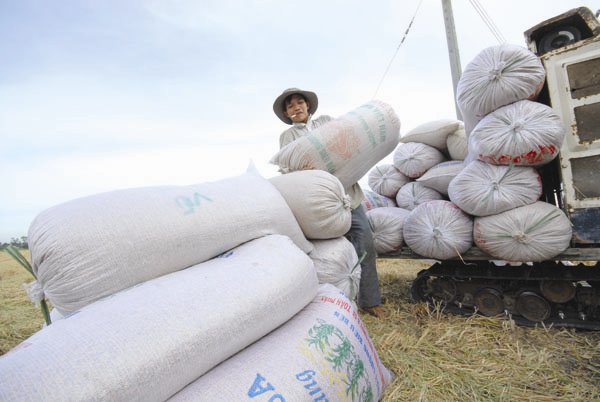The rice price in the Mekong Delta has increased in the last couple of weeks, which has resulted in higher export prices. 
Lower rice output and high demand in the world market were cited as reasons for the price increase in the domestic market.
The Vietnam Food Association (VFA) said the winter-spring rice cultivation area in Mekong Delta fell slightly by 1.2 percent, while the yield decreased by 6.7 percent on nearly half of the harvested area.
The output is predicted to decrease by 800,000 tons, or 7.8 percent, compared with the last winter-spring crop.
This is the second consecutive crop that the Mekong Delta, the country’s largest rice granary, has produced at a lower output, which is unprecedented in the last two decades.
However, Nguyen Dinh Bich, a rice expert, cited the March report of the US Agriculture Department as saying that the total rice output this year would reach a record high of 480 million, or 16 times higher than Vietnam’s decrease.
| The winter-spring rice cultivation area in Mekong Delta fell slightly by 1.2 percent, while the yield decreased by 6.7 percent on nearly half of the harvested area. |
The rice output in Thailand and India, Vietnam two largest rivals, will increase by 5 million tons, or 10 times higher than Vietnam’s decrease.
Thailand, the biggest rice exporter, is making every effort to clear the 2.8 million tons of stockpile carried forward from the predecessor's government. The rice is 36-66 months old and its quality is decreasing rapidly.
The US agriculture department also predicted that the total global demand for rice this year would increase slightly by 800,000 tons, or just 1/10 of the total output increase and one-third of Thailand’s inventory level.
All these factors show that the world market this year will be a buyers’ market, and Vietnam will not be able to control the price.
An analyst warned that Vietnamese rice exporters would find it difficult to obtain export contracts if they continue increasing the prices.
According to FAO and TREA, the Thai rice exporters’ association, Thai companies exported 5 percent broken rice at $377 per ton in January, while it slightly decreased to $368 per ton.
Meanwhile, according to Bich, Vietnam’s export price has surged from $335 to $358 per ton. This means that the gap between Thailand’s and Vietnam’s export prices has narrowed.
Bich, in his article in Thoi Bao Kinh Te Sai Gon, said that Vietnam raised the export price to equal or higher than Thailand’s price in early 2016 and saw export volume fall dramatically.
Chi Mai / vietnamnet